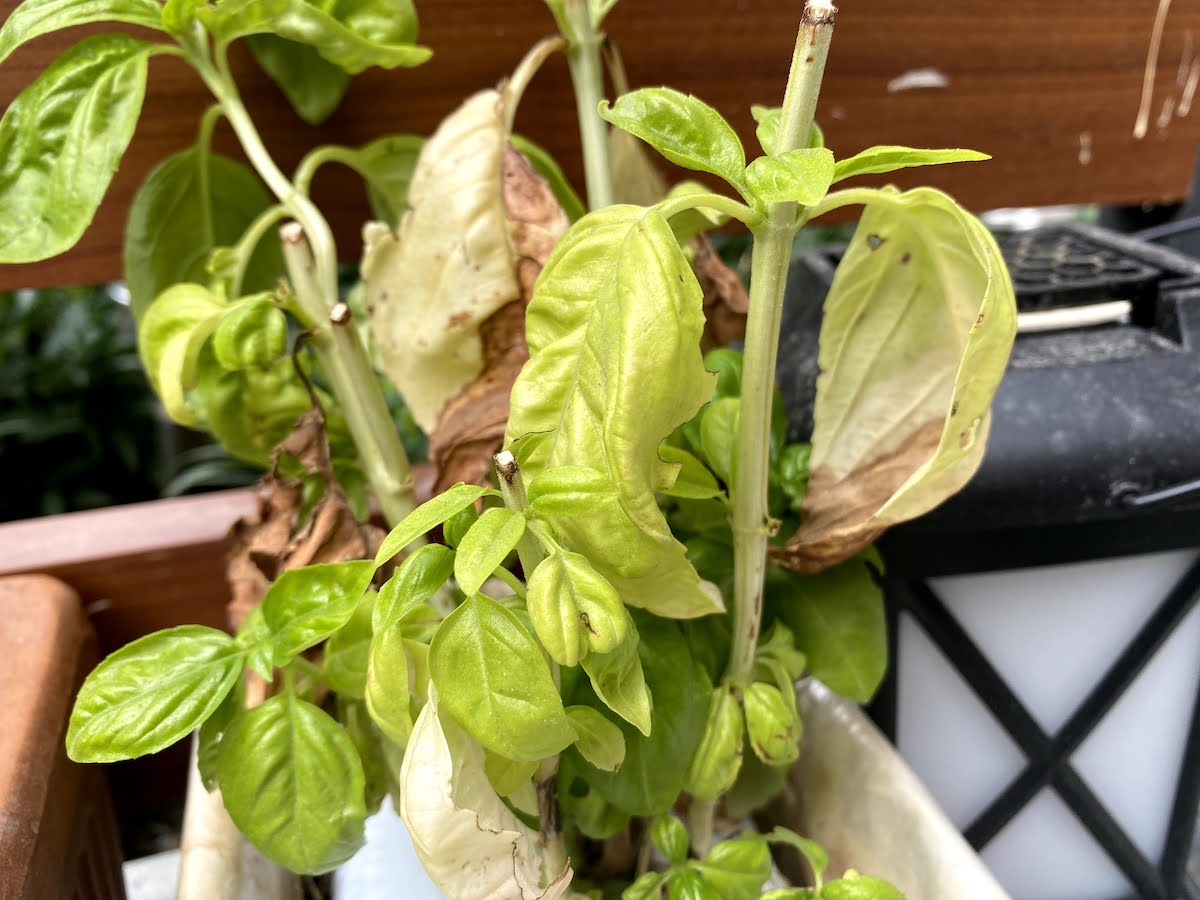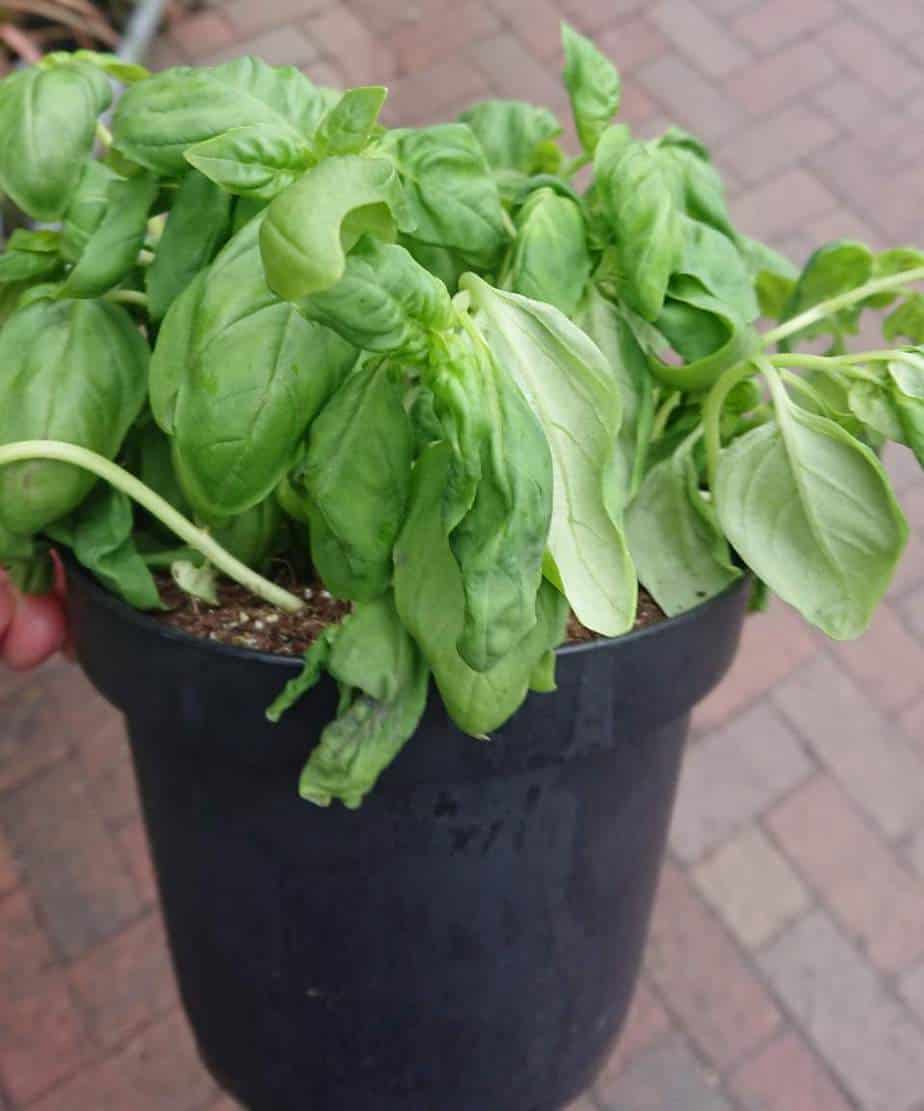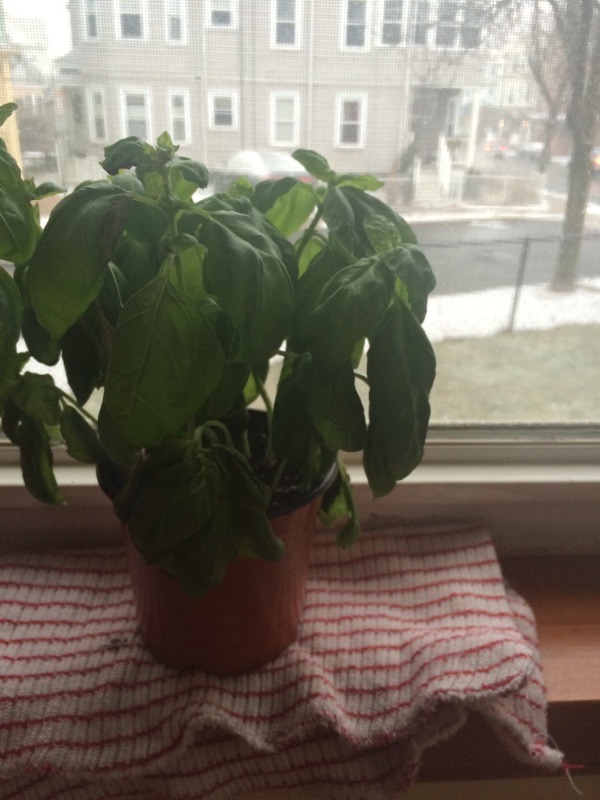The most frequent cause of basil withering is dry soil. To avoid wilting or drooping, basil needs porous, moist soil and frequent watering in hot weather. Basil wilts because little pots in the sun dry out too rapidly. Also capable of causing wilting is constantly soggy soil.
An herbaceous plant like basil thrives in damp, nutrient-rich soil. Other causes of basil wilting or drooping include:
- insufficient irrigation during hot temperatures
- Too much wetness brought on by poorly drained pots or soils that drain slowly
- Planting basil in little pots that dry out and heat up rapidly in direct sunlight
- Wilting in the months following flowering or near the end of the growing season (basil herbaceous is an annual)
- changes in the temperature (such as a cold snap or heat wave)
- Transplant shock might occur because of a contrast between the circumstances in the garden center and your garden (in terms of temperature, light, watering, etc.).
- Regular pruning helps prevent a plant from looking wilted or drooping.
For a strong, healthy plant, always grow basil in full sun (six or more hours per day).
To find out what is precisely making your basil wilt and how to fix it, keep reading.
Table of Contents
Not Watering Basil Frequently Enough
The leafy herb basil has evolved to grow in continuously damp but well-draining soil.
With porous, friable compost and frequent watering, it is possible to create this balance of a growing soil profile that is moist but well draining.
Due to its large, proportionate leaves that transpire a lot of water and lack of woody stems, basil will wilt very fast if it is allowed to dry out for any period of time.
If you can touch the soil and it seems dry, water the basil right away with a deep soak. Basil in a container should be watered continuously until a trickle of water appears from the drainage pores at the base.
If it’s a scorching summer day, shade the basil during the warmest portion of the day to give it a chance to recover from its wilted state without having to endure the intense heat. After the basil has recovered, reposition it in direct sunlight while maintaining soil moisture.
After two days of moist soil and the proper growing conditions, basil should show signs of recovery from wilt caused by underwatering.
Basil won’t wilt if you add a mulch around the base of the plant, such as leaf mold or well-rotted manure, which will aid to retain moisture and add nutrients.
Basil plants may require daily watering on hot days to prevent the plant from wilting and watering every three to four days in cooler, more gloomy weather. Water basil as frequently as necessary to ensure the soil is moist to a depth of one inch.
Always water at the plant’s base rather than overhead to help ward against fungi that can cause diseases like powdery mildew. To give the basil a water boost before a hot day, water it in the morning.
This picture shows how the dirt has separated from the pot’s side due to its extreme dryness. If this is the case, water your basil right away and make an effort to water it regularly to keep the soil from drying up and the basil from withering.
In order to help you find the proper balance while watering basil plants, I produced an article with a helpful table on how to water basil plants. Watering basil can be challenging in many regions.
Too Much Moisture (Soil is boggy and not well draining)
Boggy ground may result from:
- basil plants being planted in slowly draining soil (such as clay).
- basil plants being grown in pots or containers without drainage holes in the bottom (or the use of a drip tray to catch water).
Basil is best sown or planted in pots since you have complete control over the soil profile.
For growing basil, I choose multi-purpose compost from the garden center since it holds onto water and is free of soil diseases like fusarium wilt, which can make your basil wilt.
Basil can be grown in containers to avoid soils with poor drainage or soggy soils that retain too much moisture. Basil can wilt and become yellow as an indication of stress when the soil is consistently moist, which also causes root rot.
Basil should be grown in big pots or containers with drainage holes at the bottom so that water can drain away and the soil may retain its ideal moisture balance while also being well-draining.
When growing basil indoors, I frequently observe individuals using drainage-hole-equipped pots, but they also put a drip tray or saucer underneath the pot to collect any excess water that could otherwise pour out onto the window sill or furniture.
Basil may wilt as a symptom of stress if drip trays used to catch excess water make the soil excessively soggy.
If you are growing basil inside, I advise moving the pot outside to water it so that water does not ruin any furniture or covering the pot with a paper towel for about 30 minutes until the water stops dribbling out of the bottom of the pot.
Pot size too Small (Soil dries too Quickly and Basil Wilts)
Basil plants are frequently grown in too-small pots, which is one of the most frequent causes of wilting. Basil should be repotted in a bigger pot in the garden because the pots it comes in at the garden center are frequently too small.
Basil is a hardy herb that grows well in a variety of pots and containers (as long as they have sufficient drainage), but pots that are too small can rapidly dry out in the hot sun.
Basil grows best in broad sunlight, but as small pots have less soil and can therefore contain less moisture, basil does not do well in them. Instead, they tend to dry up too quickly.
Additionally, keep in mind that metal and plastic containers conduct heat, which leads to increased soil evaporation and premature wilting of the basil.
Basil can be grown effectively in small pots if the soil moisture levels are regularly monitored and watered appropriately, but the plant will always be more susceptible to drought.
The answer is…
The easiest technique to stop basil from wilting in a pot is to plant it in a larger pot or container with a minimum diameter of 12 inches and use terracotta, clay, or ceramic pots rather than metal or thin plastic ones because these materials do not heat up as quickly.
When handled gently and watered as often as necessary to keep the soil moist and prevent wilting, basil can be moved into a larger pot.
(Read my post on how to save a basil plant from death.)
Basil Wilting After Flowering (Requires Pruning)
Basil can blossom if it is not frequently clipped for its tasty leaves. Although the plant will go to seed and cease growing new leaves after flowering, the blossoms are appealing to pollinators and have a sweet perfume, so this is not necessarily a bad thing.
Basil frequently wilts after flowering, and at this point the leaves are less useful for cooking.
The majority of basil cultivars are fragile annuals that only live for one year, but you can save the seeds for planting in the spring of the following year, and they are frequently fairly affordable in garden centers.
Regular pruning from the top of the plant creates a bushier, more productive basil plant that lasts much longer and allows more light to reach lower leaves. Prune basil plants frequently to maintain their health, avoid going to seed, and keep them from looking wilted.
Read my article Why is my basil blossoming for additional details.
Fluctuations in Temperature and Transplant Shock
Basil is a delicate plant that is sensitive to temperature changes and extremes, which is why the majority of cultivars are thought of as annuals.
Even though the temperature has not dropped below freezing, basil might wilt as a sign of stress if there has been a prolonged period of pleasant weather followed by a sudden cold snap.
If the basil suffers from any cold-related damage, such as curled leaves or brown edges on wilting leaves, remove those leaves to encourage the growth of additional healthy leaves and hasten the plant’s recovery.
See how to trim basil in this video to keep it healthy and encourage it to grow plenty more tasty leaves:
Wilting Basil due to Transplant shock
When there is a sudden change in temperature, wilting frequently occurs. However, if you move the plant indoors or put it in a heated greenhouse if additional cold weather is predicted, it will likely recover (and place the plant back out in full sun during the day or in a sunny window).
This is typical and is sometimes referred to as transplant shock when you buy your basil plant from the garden center and place it in your yard.
The basil plant adjusts to these particular conditions when grown from seed in a garden center or plantation, so when you plant the basil in your garden there is a variance in temperature, humidity, watering frequency, etc. that might be a shock to your basil and cause it to wilt.
The basil plant must receive all the attention it needs and must adjust to its new surroundings in order to avoid wilting after transplantation. This necessitates that your basil:
- grown in direct sunlight
- The compost retains moisture while having good drainage.
- Enough water is provided to the basil for the compost to be constantly moist but not soggy (adapt the frequency of your watering according to the weather)
- Bring the pot under cover to protect the basil from bad weather (such as strong winds, persistent rain, and cold weather).
If you make the necessary changes to ensure that the basil may grow, it should begin to show indications of recovery from transplant shock within a few days and, ideally, should appear considerably better within two weeks.
High Temperatures
High temperatures can also promote withering in basil, much like an unexpected cold snap does.
Basil can withstand high temperatures as long as the soil is maintained moist because it is a native of tropical climates in South East Asia and Africa.
The plant becomes stressed and quickly wilts if you let the soil dry out in hot weather, but it can recover with a good soak and moisture monitoring.
Make sure to water it frequently so that the soil is continually moist (but not soggy), and if the basil is planted in good compost that holds moisture, the plant should recover from withering in high temps if the weather changes rapidly rather than it suffering because of the heat.
When using mulch, I would advise doing it if your basil is wilting in the heat. In warmer weather, a mulch placed on top of the soil around the basil will help to keep the soil cool and moist.
Compost, leaf mold, and well-rotted manure are excellent choices for mulching around basil plants since they all help the soil retain moisture and provide nutrients that the basil plant needs to stay healthy.
Prune Basil Regularly to Prevent it Wilting
A healthy soil that has been improved with additions like alfalfa or all-purpose nitrogen fertilizer encourages growth for more leaves, allowing for more frequent harvesting.
However, if the plant receives a lot of nitrogen, it can develop quickly and, because the stems are herbaceous, droop under its own weight if regular harvesting is not done.
To ensure that the basil develops properly, keep up frequent pruning and collect the top leaves. With a few basil plants, you can have more leaves than you can reasonably use for cooking!
There are many reasons why basil can become lanky, therefore I wrote another post about it to assist you identify the issue and revive lanky basil.
Key Takeaways:
- It is dry soil that causes basil plants to wilt. In order to keep healthy, basil needs wet soil and frequent irrigation during hot weather. However, bog rather than damp and well-draining soil can also cause basil to wilt. Basil will wilt and turn yellow in wet soil as an indication of stress.
- Basil will wilt if it is grown in small pots because the soil dries up too rapidly in the sun. Greater soil and moisture capacity in larger pots helps keep the basil from wilting.
- Because of its sensitivity to temperature changes, basil. Wilting can be brought on by temperature extremes. Trim off any frost-damaged leaves and bring the basil indoors to keep it warm until the weather rises. With regular watering, basil that has wilted in hot weather will bounce back. Before the basil flowers, remove any leggy growth to keep it from looking wilted.
- Basil may wilt as a result of transplant shock due to the differences in environmental conditions between a garden center and your garden. Basil should recover from a wilted appearance if you give it some time to acclimate and make sure it is planted in full sun with soil that retains water but is well draining.
- When basil is grown in fertile soil and is fertilized frequently, it has a tendency to become lanky and droopy, especially if it is not routinely clipped. To maintain a healthy form and stop the plant from drooping, harvest the top leaves of the basil plant on a regular basis. The plant is prevented from sagging under its own weight by leaf harvesting, which also encourages the growth of lower leaves.
FAQ
How often should you water basil?
Basil prefers to keep moist, and it needs about one inch of water per week. To keep the soil moist and the roots developing deep, water deeply at least once a week.
How much sun and water does basil need?
Basil likes slightly moist soil that is neither too wet nor too dry. The soil should be somewhat moist but not soaked. Despite the fact that basil enjoys warm weather, a harsh noon sun can be unpleasant. If your basil plant only appears to be withering during the hottest parts of the day, you might need to provide some light shade.
Can basil get too much sun?
If basil receives too much sun, it may get leaf burn. However, avoid growing basil in the shadow. Don’t rush planting your plants in the spring since basil need warm soil and air to thrive.
What does Overwatered basil look like?
The first indication that basil has received too much water is when the leaves begin to yellow or become brown. Additionally, the basil plant will begin to wilt, and if it has received excessive water for a lengthy period of time, the roots will start to rot and smell moldy.
Why is my basil so droopy?
Basil plants can wilt due to either too dry or too damp soil. Basil plants benefit from full sun, but they also require continuously moist, premium soil with good drainage. Check the soil and rethink your basil watering schedule if your plant is withering or drooping.



